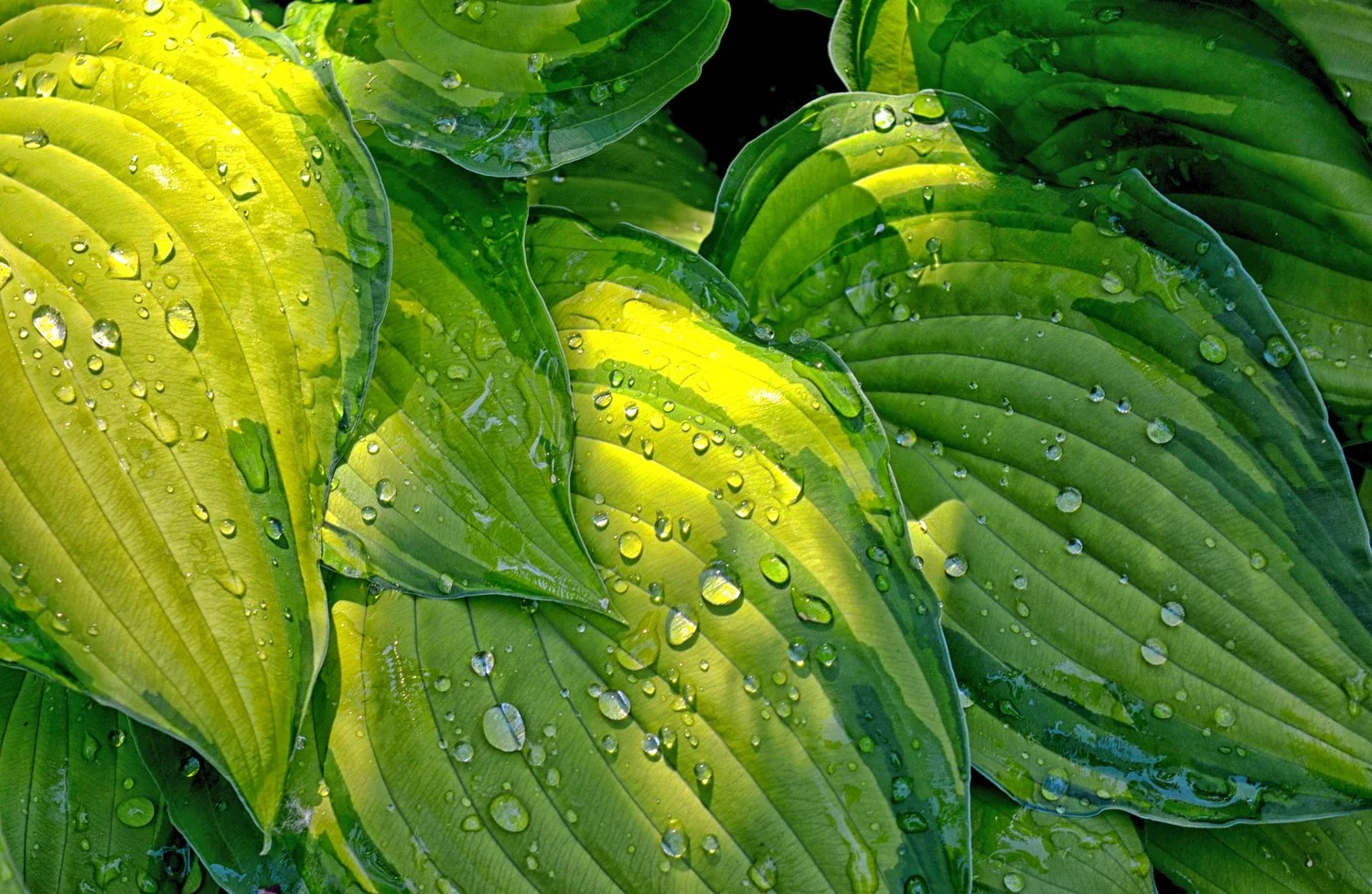The Genus Hosta: Lush Foliage & Delicate, Lilylike Flowers
By Corinne Kennedy
Hosta with Koi in the Seattle Japanese Garden (Mary Ann Cahill)
By early summer, the colorful flowers of spring-blooming trees and shrubs have gone, and green is the predominant color in the Seattle Japanese Garden. Soon, however, the non-woody (herbaceous) genus Hosta comes into flower and brings to the July garden subtle shades of lavender, white, green and yellow. And hostas, unlike most woody plants, also provide a layer of lush foliage that covers – with a variety of leaf shapes, sizes, textures & colors -- what would otherwise be expanses of bare soil.
Hostas are native to East Asia -- notably Japan, but also China and Korea. It’s believed that they evolved from lilylike ancestors native to east-central China. These ancient plants migrated from there by two main routes and recombined later to create the hostas of today. One group moved northward through southeastern Russian into northern Japan. The other group moved through southern Manchuria and Korea into southern Japan. Over the centuries, the two populations continued to differentiate, with some species remaining geographically isolated, but the various species remained capable of interbreeding. In Japan, more recently, wild plants and naturally-occurring hybrids were used to breed cultivars (cultivated varieties, also known as plants “of garden origin”) with ornamental traits.
The complex history of migration, differentiation and naturally-occurring hybridization has made scientific classification difficult. Hostas were originally placed in the Lily Family (Liliacae), but in the late 20th century it was decided that they merited a family of their own, Hostaceae. In addition, the genus name itself has undergone various changes: Hosta was replaced by Funkia, but the latter name was eventually abandoned and the name Hosta (common name, plantain lily) reinstated.
Variegated hosta foliage with raindrops (Riley Sawyered)
Hostas are clump-forming plants, with leaves that are usually described as heart-shaped, lance-like or cupped. A central crown with fleshy roots and spreading rhizomes (underground stems) is located below ground. Purplish, conical shoots form on this crown in autumn, then emerge & expand in spring as typically broad, showy leaves. Individual plants range in size from 6 inches tall by a foot or less wide to 3-4 feet tall by 5-6 feet wide. Accordingly, leaf size ranges from miniature (1-2 inches long) to very large (several feet long). Leaf thickness and texture may be smooth, veined, or puckered. Colors range from bright green to blue or yellow – with some cultivars noted for showy variegations. Contrasting leaf edges or centers may be white, cream, yellow or green, or the patterning may include splashes of color against a single-color background.
Hosta Foliage & Flowers in the Seattle Japanese Garden (Tony Monk)
Although Hostas are most often appreciated for their exotic foliage, their July flowers are also ornamental, and some are very fragrant. The lilylike, bell-shaped blooms appear on long stalks (known as racemes) and are attractive to hummingbirds & bees. Colors include white, lavender and blue.
Wild species most often grow on forest edges or in open woodlands, and benefit from the high rainfall of Japan’s main islands, which averages about 62 inches per year. Most cultivars have been derived from these wild plants. A few species are from more extreme habitats – dense shade, exposed cliffs, damp mountain meadows, wet bogs, tree trunks (growing as epiphytes), and rocky steam edges. Cultivated varieties as well as the wild species are reliable hardy (to about -35 degrees F). To achieve the dormancy that gives them this cold hardiness, they require several weeks of winter temperatures below +40 degrees F.
Plants grow best in shade or part shade in rich, moist, organic soil, but when established, and with sufficient shade & moisture, they tolerate less than ideal conditions. Unfortunately, the leaves -- especially those varieties with thin, delicate foliage -- are attractive to slugs and snails. Plants with blue or thick, puckered leaves are somewhat resistant to attack. Deer, however, are attracted to the foliage and flowers of all varieties.
Hostas have been known in Japanese art since at least the 11th century. Their leaves were represented in temples and on bridges, and larger varieties were used to landscape temple grounds. Leaves were also used to wrap Buddha statues and to construct the raftlike platforms that displayed them.
Plant parts do not contain alkaloids or medicinal substances, so hostas were not used in traditional medicine, and are edible. In mountainous areas of Japan unsuitable for agriculture, they became an important food source, and were known as sansei (mountain vegetables). Along with other wild herbs, they were grown on Honshu as vegetable crops. The leaf stems (petioles) were eaten raw, cooked & pickled; the leaves themselves were generally boiled until tender. Young leaves were eaten raw in salads or fried in tempura. The flowers, also edible, are described as having a peppery flavor. Considering the beauty of their foliage, and the expense of purchasing the newest, most popular selections, it’s unlikely that Westerners will choose to grow hostas for food.
In the Seattle Japanese Garden and in our own private gardens, we value the striking colors and patterns that hostas bring to shady areas -- especially in summer, when spring-blooming bulbs and ephemerals (non-woody plants that are summer-dormant) have disappeared below ground. Gardeners interested in growing hostas at home will enjoy a recent article by local expert Ciscoe Morris -- “One-Stop Hostas,” published June 10, 2018, in the Pacific NW Magazine of The Seattle Times.
Corinne Kennedy is a Garden Guide, frequent contributor to the Seattle Japanese Garden blog, and retired garden designer.



